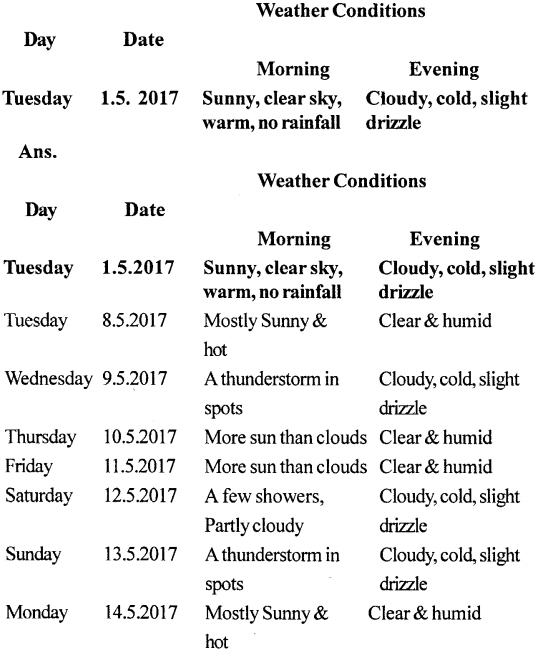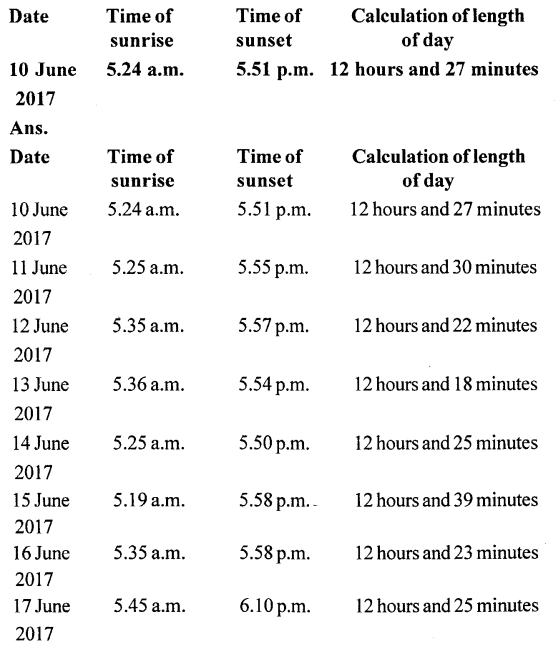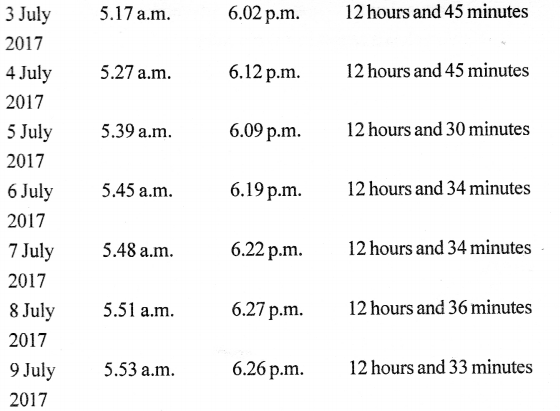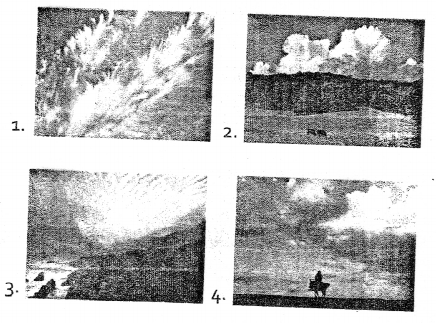ICSE Solutions for Class 7 Geography Voyage – Recording of Weather
ICSE SolutionsSelina ICSE SolutionsML Aggarwal Solutions
APlusTopper.com provides step by step solutions for ICSE Solutions for Class 7 Geography Voyage. You can download the Voyage Geography ICSE Solutions for Class 7 with Free PDF download option. Geography Voyage for Class 7 ICSE Solutions all questions are solved and explained by expert teachers as per ICSE board guidelines.
ICSE Solutions Class 7 Geography History & CivicsMathsPhysicsChemistryBiology
Discuss
How are dew drops beneficial for plants ?
Answer:
In the early morning dew surrounds the leaves of plant with moisture and plant does not close its stomata.
EXERCISES
A. Answer the following questions in brief
Question 1.
What is relative humidity? How does it differ from absolute humidity ?
Answer:
Relative humidity is the ratio of the actual amount of water vapour present in the air and the total amount the air can hold at a given temperature. It is expressed in percentage.
While absolute humidity is measured in grams per cubic metre.
Question 2.
What does a large difference between the temperatures of a dry bulb thermometer and a wet bulb thermometer of a hygrometer indicate?
Answer:
A large difference between the readings of the two thermometers means low relative humidity and a small difference between them means high relative humidity.
Question 3.
Differentiate between precipitation and condensation. Give one example of each.
Answer:
Condensation – Dew is a form of condensation. Condensation is the process by which water vapour in the air gets converted into tiny droplets of water or ice. Dew formsin winters when the temperature is very low but not below 0°C. Moist air comes in contact with the cold surfaces near the ground. The water vapour in the air changes to water and we see it as dew drops on grass or on plants. Dew drops are beneficial for plants. Precipitation – Precipitation is the falling of atmospheric moisture as a result of condensation. It has many forms such as rainfall, snowfall, and hail.
Question 4.
What are nimbus clouds?
Answer:
Nimbus are real rain clouds-thick, dark and black and spread out in layers. They cause continuous rain or snow.
Question 5.
What is the Beaufort scale?
Answer:
Beaufort scale is the scale that is used to estimate wind speed. The scale is based on the effect of the wind at different speeds.
B. Answer the following questions in one or two paragraphs
Question 1.
What is a hygrometer ?
Answer:
The instrument used for measuring relative humidity is called hygrometer. The hygrometer consists of wet and dry bulb thermometer. The dry bulb thermometer is an ordinary thermometer while the wet bulb thermometer is kept wet by a wick that dips into a container of distilled water. The wet bulb thermometer shows the lower temperature than the actual temperature as evaporation from the moist wick has a cooling effect. A larger difference between readings of two thermometers means low relative humidity and small difference means high relative humidity.
Question 2.
Describe the various types of clouds.
Answer:
The four types of clouds are :
(a) Cirrus clouds — These are feathery, fibrous clouds which form at very high levels of 5 to 10 km. They consist of tiny crystals of ice and look like wisps of cotton floating in the sky.
(b) Cumulus clouds — These are cauliflower-shaped clouds that have great vertical height and a flat base; they cause rainfall with lightning and thunder, and are usually white or grey in colour.
(c) Stratus clouds — These are sheet-like clouds that spread out 42 Arundeep’s Self-Help to Voyage-7 over the whole sky. They usually form at low levels, less than 2 km. They are uniformly grey and dull.
(d) Nimbus clouds — These are the real rain clouds – thick, dark and black, and spread out in layers. They cause continuous rain or snow.
Question 3.
What is wind? What precautions must be taken while placing a wind vane?
Answer:
Wind is air in motion. A wind vane indicates the direction of the wind and consists of a rotating arm pivoted on a vertical rod. The arrow of the wind vane always points in the direction from which the wind blows and the wind is named accordingly. For example, if the pointer is pointing to the East, the wind is blowing from East to West and, therefore, this wind is called an easterly wind. Wind vanes are usually placed away from obstacles such as high buildings, trees, etc.
Question 4.
What are isohyets and isotherms ?
Answer:
Isohytes : A weather map, which shows, by the help of lines, the amount of rainfall a place receives. Each of these lines is made by joining points that show the same amount of rainfall received in a given period. These lines are known as isohyets.
Isotherm : On the map, places experiencing the same temperature at a given time are connected with a line. This line is known as an isotherm. Each of these points on the line reflects one temperature reading, or an average of several readings, over a period of time.
Question 5.
What is a weather report ? How is weather forecast made? Why is weather forecast necessary ?
Answer:
When the weather conditions of the previous day are published, it is called a weather report. Weather forecasting is the application of science and technology to predict the state of the atmosphere for a given location. Nowadays it is made with the help of data gathered from weather satellites and radar systems. Forecasts help to plan what to wear, when to travel or which products to stock in super markets. It’s specially important for farmers, builders, sailors or anyone else who works out doors.
C. For a week, gather information on the weather conditions of your city using simple instruments or from weather reports published in newspapers. Present this information in a table. One has been done for you here. My observation of the weather at for a week.

D. This could be a classroom activity. If your school laboratory has an anemometer, use it to record your city’s wind speed for a week. Use the Beaufort Scale to find out the character of wind during these days. Record your observations carefully in your notebook. You could even draw small neat sketches to show the effect of the wind.
Answer:
Do it Yourself
E. From the weather report published in your local newspaper, record the time of sunrise and sunset for a month in your notebook, as shown on the next page : My observation of the time of sunrise and sunset for the month of ______ 20, ______




F. Picture Study

- Identify the four types of clouds shown in the photographs.
- Which of these causes heavy rainfall?
Answer:
1.(a) Cirrus clouds
(b) Cumulus clouds
(c) Stratus clouds
(d) Nimbus clouds
2. Nimbus clouds causes heavy rainfalls.